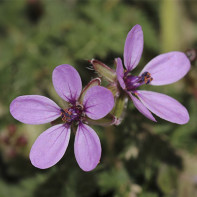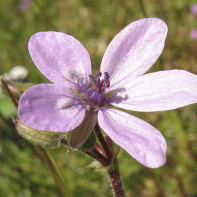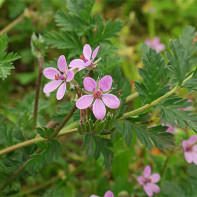Stork: medicinal properties and contraindications
Stork is considered one of the most common species of weeds. It occupies large areas on vacant lots, landfills, forest edges. Undemanding to living conditions the grass feels at ease in vegetable gardens and fields, where cereal crops are grown. It is quite understandable that such aggressive behavior of the stork makes the dacha owners take measures to eliminate the green "occupant". But, putting all their energy into fighting this plant, they do not think about the fact that this pretty weed can be a valuable medicine.
- Chemical composition
- How it looks and where it grows
- External characteristics
- Area of distribution
- Types
- Gathering and storage
- Stork medicinal properties
- Stork in folk medicine
- Infusion for epileptic seizures
- Remedy for sore throat
- Bath Therapy
- Ointment
- Stomach infusion
- Blood Stopping Agent
- Eyes remedy
- Remedy for bloating
- Tincture for hemorrhoids
- Types of medicinal compositions
- Tincture
- Tincture
- Decoction
- Contraindications to use
Herbalists have long known about the healing capabilities of cranesbill, as stork is often called popularly. The unique composition of this unpretentious plant is saturated with vitamins and a whole complex of other useful elements. On the basis of the herb you can prepare decoctions, ointments and infusions. Simple dosage forms at home can help improve overall health and cure many diseases.
Chemical Composition
Common stork belongs to the wild species of annual herbs from the family Geraniums. The composition of the plant is a well-balanced formula of substances belonging to different chemical groups. And highly active biological compounds of human health value are contained in all parts of the plant. The following important components are worth noting:
- ascorbic acid;
- vitamin K;
- flavonoids;
- fatty oils;
- organic acids;
- saponins;
- resins;
- tannins;
- complex of mineral elements;
- carotenes;
- carbohydrates.
The composition of different parts of the herbaceous plant differs in the content and concentration of useful substances. Thus, most of the vitamins and organic acids are concentrated in the stem and leaves, and fatty oils account for most of the composition of the seeds. The combination of all these elements ensures their close interaction with each other. Thanks to this synergy, the human body gets the maximum benefit from the compositions prepared according to folk recipes.
How it looks and where it grows
Stork cicuta is widely distributed in the wild. There are annual and biennial species. Depending on the area of growth, the herb is called differently: rake, needlegrass, wild carrot, magpie needles. Other local names for the wild plant are also popular, but each reflects a specific feature of storkweed.
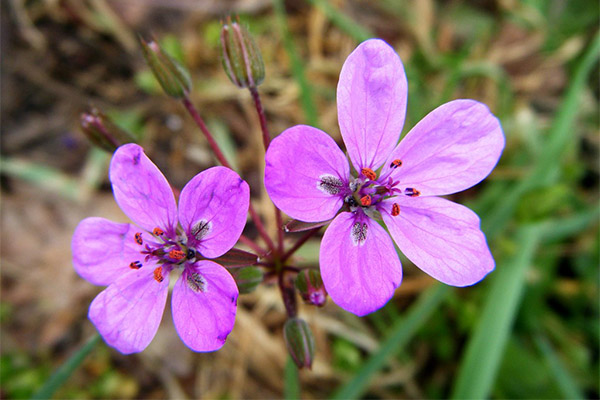
Despite its adherence to the wild way of life, the storkberry is a good honeybee. Therefore, during its flowering period, bees hover over thickets of cranesbill, diligently collecting valuable nectar.
External characteristics
- The stem-shaped root really resembles a carrot, covered with hairs.
- The stem branches out at the very base, reaching a height of no more than 60 cm.
- The feathery leaves are covered with tufted foliage and have leaflets.
- The simple flowers of the plant are more often colored in purple, pink or magenta. Dark veins are noticeable against the general background. They are arranged in an umbrella-like inflorescence of 3-8 flowers. The flowering period in Needlegrass lasts from May until fall.
- Fruits, which ripen by mid-autumn, are shaped like a stork's head with a massive beak. Hence such an unusual name for the plant. The seed is covered on the outside with tough sparse villi.
Area of distribution
The stork is found throughout Eurasia, the plant has taken root in America and Australia. Prefers sandy soils, so it often forms thickets near private houses, along roads, in vegetable gardens.
An interesting fact: Common stork is often confused with Robert's geranium. But despite some external similarity, these two plant species differ: the geranium has a bright unpleasant fragrance and larger leaves compared to the cranesbill.
Species
The common stork is a typical representative of the genus of the same name, numbering about 130 subspecies. Basically these are all wild species widespread in nature. Only six varieties of this species variety are cultivated and cultivated for decorative purposes. It is worth noting that stork species used for landscape decoration are as unpretentious and resistant to the environment as their wild relatives. Varieties in demand in decorative floriculture:
- Reichard's stork (Dubrovnik) in turn is subdivided into two subspecies: "Roseum" and "Alba". This is the most popular variety, which florists consider the benchmark for its spectacular appearance. Really tender light pink or white florets of this species with bright burgundy stripes on the petals look very beautiful against the surrounding greenery.
- The Corsican variety of ornamental stork is attracted by its compactness and expressive inflorescences, which seem enormous on the velvet gray foliage.
- The stony variety first became cultivated in Spain. This heat-loving plant forms a stiff cushion of leaves, so it looks less welcoming compared to other species. But the Spaniard has a long blooming period, which pleases gardeners. Each petal of graceful flowers is decorated with a complex pattern of pink and cherry veins, and the whole composition is completed by bright purple and ink spots.
- The golden stork grows slowly. This variety has two kinds of flowers: male and female, which look like daffodils.
- Tartar stork is distinguished by its bright appearance: lush green openwork leaves form an airy cushion, on which the inflorescences shine in purple. This lacy plant always attracts the attention of florists.
- The Manescavi Storkhorn is a Pyrenean shrub that reaches a height of up to 50 cm and a diameter of no more than 60 cm. The compact forms of this variety allow designers to create original floral arrangements.
Gathering and storage
Herbalists are always interested in harvesting storks, because the healing compositions based on it have universal properties. As a plant raw material, the entire above-ground part of the plant is harvested, except for the seeds. The ripe fruits, as well as the roots, are much less frequently used for the preparation of medicinal preparations. The rules of collecting the stork herb material are standard:
- Harvesting of raw materials is carried out during the active flowering of cranesbill. It is better for this purpose to allocate the second half of the day, so that the dew on the grass dries.
- The stem is carefully cut off together with the foliage at the level of the root rosette.
- Drying in the natural way should take place in a shady place, preferably under a canopy or on an open terrace. You can dry grass in a room with good ventilation or use a special machine for this purpose.
- During drying, stir the herbage regularly to prevent the valuable raw material from becoming infected with mold.
- Distribute the finished material in paper bags or cloth sacks.
- In this form, dried stork can be stored for up to two years, if all this time the raw material will be in a dry and cool place.
The seeds are collected after their full maturity, and the roots are dug out at the end of the growing season. These plant parts are also subjected to machine drying at a temperature not exceeding 50 degrees or dried naturally.
Medicinal properties of Storkwort
Stork is not included in the official list of medicinal herbs, so it is not used in official medicine. Nevertheless, physicians do not deny the healing properties of this plant and willingly recommend it to patients in addition to basic therapy. Indeed, traditional dosage forms involving cranesbill are characterized by a wide range of action. The list of the main therapeutic effects includes:
- astringent;
- styptic;
- sedative;
- expectorant;
- anti-inflammatory;
- antiseptic;
- anticonvulsant.
Many centuries of practice in the application of infusions and decoctions with useful plant proved the ability of stork to strengthen the structure of blood vessels, reducing their permeability. Preparations prepared from the dried ground part of the herb exhibit a pronounced hemostatic effect, so often used in folk medicine to stop bleeding.
Moderate sedative effect makes the plant useful for elderly people who often suffer from insomnia. Concentrated infusions and decoctions are used as a means for external treatment.
All the listed possibilities of the wild stork allow using it in the treatment of the following pathologies:
- colds and flu;
- Bronchitis and other inflammatory processes of the respiratory organs;
- bloating;
- gynecological pathology;
- hemorrhoids;
- diathesis in children;
- cramps;
- tonsillitis;
- angina pectoris;
- sleep disturbances;
- stomatitis;
- conjunctivitis;
- Infected wounds and furunculosis.
In the old days, witch doctors and midwives treated frightened children and the evil eye with infusions of Stork. Although today such practice is rarely used, but such possibilities of the plant are also worth considering.
It is useful to know: Stork in ancient times was added to the feed for sheep. At that time, such a supplement was considered very useful for the health of animals. And the powder of dried grass was sprinkled on the wounds of livestock.
Stork in folk medicine
In Chinese medicine today, the stork is very actively used. Inhabitants of the Celestial Empire add dried parts of the plant to teas. Our domestic herbalists are also quite understandably interested in this representative of wild herbs. Using the experience of the previous generations of healers, they create new plant gatherings with the stork. Folk medicine today relies on the scientific evidence base, because the composition and properties of certain types of medicinal plants have been established by research.

For practical use in home therapy, here are a few variants of time-tested recipes.
Infusion from epileptic seizures
Often an epileptic seizure occurs spontaneously. Therefore, such patients are in dire need of prompt and adequate actions of surrounding people. Of course, the proposed remedy cannot completely cure such a serious disease, but significantly ease the condition of the person after the attack is quite capable.
- Take 1 tbsp. dried stork, pour a glass of boiling water.
- The vessel with the infusion to wrap with a towel.
- After two hours, ready to filter the infusion.
Take ¼ tbsp. infusion, add to it exactly 20 drops of alcohol tincture of angelica root. This drug can be freely purchased in a drugstore or prepare yourself according to the scheme: take 10 parts of vodka per part of dried angelica roots.
Note: This uncomplicated in preparation recipe will help people suffering from epilepsy, reduce the frequency of seizures. To do this, the drug should be taken by courses of 3-4 weeks, then take the same break.
Remedy for sore throat
Will relieve pain and soothe an inflamed throat infusion, prepared from 1 tbsp. crushed dry stork and 0.3 l. of steep boiling water. The solution must be well infused for the treatment to be effective. Therefore, it is better to prepare it overnight, and in the morning, filter it thoroughly. The resulting solution rinse your throat and mouth with dental problems 4-5 times a day. For one procedure, 100 ml of infusion is enough.
Therapeutic baths
Such procedures will help to relieve the negative manifestations of diathesis in children, and adults - irritability and nervous tension. First, a concentrated decoction of common stork is prepared in the ratio: for 50 g of dry raw material 0.5 liters of water. After combining the main ingredients, the solution should be boiled for 20 minutes, then strain and pour into a full bath. The duration of water therapy is 15 minutes.
Ointment .
Preparation of this external remedy does not take much time. For the ointment will require:
- Stork dried - 2 tbsp.
- Stomach fat - half a cup.
How to prepare the ointment:
- Grind the herb to a powder.
- Mix the above components, and then melt in a water bath.
- Leave the composition for 4 days, and then melt it again.
- Do not cool the mixture, filter it and pour it into a jar.
- Store the ointment in the refrigerator, and as needed, treat pus wounds and boils to accelerate their maturation.
Stomach Infusion.
This remedy will help relieve pain in the stomach at an exacerbation of gastritis or peptic ulcer disease. To prepare a healing drink, 15 g of dried cranberry herb brew a glass of boiling water. Insist the solution for at least 6 hours, then strain it. Take the drug strictly on an empty stomach 1-2 tablespoons. Frequency of intake - 3-4 times.
styptic
Cooked according to this recipe infusion is shown to take with uterine bleeding and heavy periods. It can also be drunk as a sedative.
The sequence of preparation of the medicine:
- 2 tsp of dry raw materials pour 200 ml of steep boiling water.
- Infuse the solution for 8 hours.
- Take the strained infusion every 6 hours in 60 ml.
Remedy for inflamed eyes
For this medicine, you will need stork flowers. Give 1 tbsp of fresh or dried inflorescences with boiling water (200 ml). Put the mixture on a water bath and keep for 15 minutes over low heat. After heat treatment broth should infuse for another 45 minutes. Then it should be strained and used to rinse the eyes. Also, the decoction prepared in this way will be suitable for lotions for eczema and a simple face wash.
Note: Such decoction can be used for lotions for mosquito bites.
A remedy for bloating
Those who are constantly tormented by increased formation of gas, it is definitely worth remembering this recipe. Take 2 tsp of dried stork herb and pour a glass of boiling water. It is better to prepare the medicine for the night, because for a few hours the concentration of active substances in it will become maximum. Before use, strain the infusion and be sure to squeeze the plant material. Take the medicine for 125 ml after meals to prevent flatulence.
Tincture for the treatment of hemorrhoids
For one part of dried stork herb you will need to take 10 parts of vodka or alcohol. Insist the drug at room temperature for 10 days. Then strain the solution, and the finished tincture be placed in the refrigerator for another three days. This remedy is suitable for treating bruises, hemorrhoids, washing wounds.
In addition to being used as the basis for infusions and decoctions, young stork leaves are added to salads in some Asian countries. The taste of the greens of this wild plant resembles parsley. The herb may well be used in home cosmetology, as well as for some domestic tasks:
- For example, fresh stork is still used in some countries to produce a natural green dye.
- To preserve watermelon seeds, they should be mixed with stork grass powder before sending them to storage.
Types of healing compositions
As can be seen from the above recipes, stork herb can well be considered a universal raw material for the preparation of the most popular in folk medicine medicinal forms. For the treatment of different pathologies, their own proportions are used, which must be strictly observed. There are many variants of such preparations, but among them there are classic formulations.
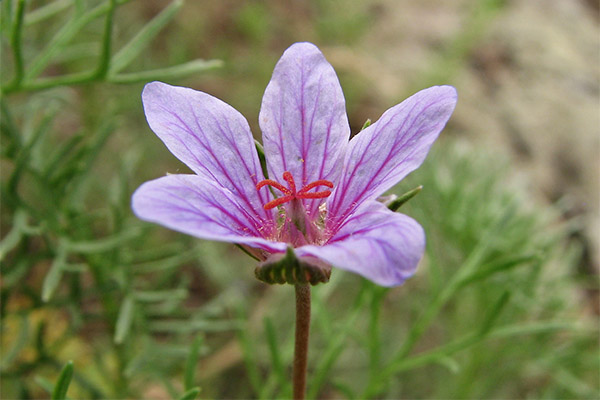
Infusion .
This antiviral remedy will alleviate the condition in flu and respiratory infections, as well as suitable for improving the general condition when overworked.
Algorithm of action:
- Dried stork in the amount of 2 tsp. pour chilled boiled water (1 cup).
- Insist the mixture for 8 hours.
- After this time, strain the solution.
- Take 50 ml of infusion up to 4 times until the condition improves.
Tincture
This recipe can be used to make a tincture for the treatment of wounds, acne and pustules.
Method of preparation:
- In a jar, pour 15 g of dry grass cranesbill.
- Pour 0.2 liters of vodka.
- Insist 12 hours, then strain the solution.
- Tincture wash wounds, but you can gargle the throat of adult patients.
Decoction .
According to the classic recipe, decoction of stork herb is prepared as follows:
- Combine 10 g of dry raw materials and 200 ml of hot water.
- A container with the composition put on a slow fire.
- Boil the mixture for 5 minutes.
- When the decoction cools, strain.
- Take on an empty stomach 1-2 tsp.
Contraindications for use
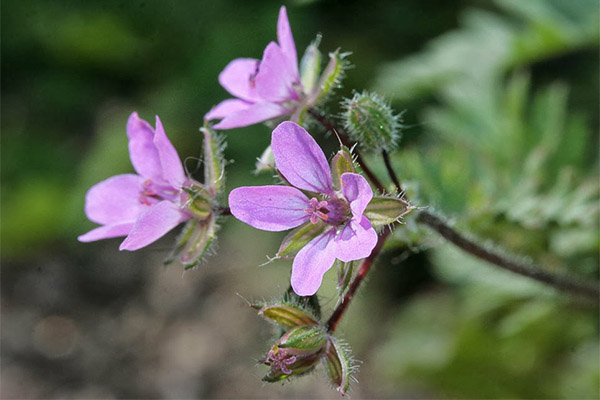
Of course, the therapeutic properties of stork if used correctly will benefit the condition of the sick person, which will accelerate the recovery. But we must not forget that any herbal medicine can cause the opposite effect. Stork also, in addition to the pros, has a limited list of cons. Absolute contraindications to the use of this type of plant for medicinal purposes are the following conditions:
- pregnancy;
- Breast-feeding period;
- Children under the age of three years;
- varicose veins;
- stable hypertension;
- diabetes mellitus of the first type;
- thrombophlebitis;
- individual intolerance;
- Increased blood clotting.
It is also forbidden to take compositions with stork after a heart attack and coronary heart disease. In the case of overdose, vomiting, nausea, liquid stools may be observed. In such a situation, measures to relieve intoxication will be required: gastric lavage and taking several tablets of activated charcoal. If the patient's condition does not stabilize, hospitalization will be required.
Familiarity with the common stork proves that there is nothing superfluous in nature. Every blade of grass and wild flower conceals useful properties. The secrets of healing plants were well known to our ancestors. Therefore, such useful plants such as stork, in those olden days were faithful helpers of the people.
«Important: All information on this site is provided for informational purposes only. for informational purposes only. Before applying any recommendations, consult a specialist. specialist before applying any of the recommendations. Neither the editors nor the authors shall be liable for any possible harm caused by materials."

